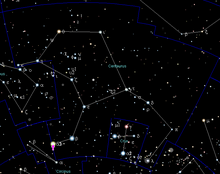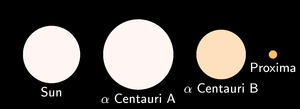Alpha Centauri: Difference between revisions
oh, "nearby" meant in terms of angular distance |
clarification and addition to same section |
||
| Line 6: | Line 6: | ||
==Names== |
==Names== |
||
It bears the proper name '''Rigil Kentaurus''' (often shortened to '''Rigil Kent'''), derived from the [[Arabic language|Arabic]] phrase ''Al Rijl al Kentaurus'', meaning "foot of the centaur," but is nonetheless usually referred to by its [[Bayer designation]] ''Alpha Centauri''. Another alternative name is '''Toliman''' from a [[Hebrew_language|Hebrew]] word meaning "the heretofore and the hereafter". It is also sometimes known as '''Bungula''', possibly from the [[Latin]] word ''ungula'' meaning "hoof". It and [[Beta Centauri]] ( |
It bears the proper name '''Rigil Kentaurus''' (often shortened to '''Rigil Kent'''), derived from the [[Arabic language|Arabic]] phrase ''Al Rijl al Kentaurus'', meaning "foot of the centaur," but is nonetheless usually referred to by its [[Bayer designation]] ''Alpha Centauri''. Another alternative name is '''Toliman''' from a [[Hebrew_language|Hebrew]] word meaning "the heretofore and the hereafter". It is also sometimes known as '''Bungula''', possibly from the [[Latin]] word ''ungula'' meaning "hoof". It and [[Beta Centauri]] (which is close to Alpha Centauri in [[angular]] distance as seen from the Earth, but is actually many light-years away) are the "Pointers" to the [[Crux|Southern Cross]]. Alpha and Beta Centauri are the second closest pair of first magnitude stars as seen from the Earth, and due to the effects of [[proper motion]], they will become the closest pair in around 2166, overtaking [[Acrux]] and [[Becrux]] |
||
[[Alpha Centauri A]] is also known as [[Henry Draper Catalogue|HD]] 128620, [[Harvard Revised catalogue|HR]] 5459, [[Cape Photographic Durchmusterung|CP-60°5483]], [[General Catalogue of Trigonometric Parallaxes|GCTP]] 3309.00A, and [[Luyten Half-Second Catalogue|LHS]] 50. |
[[Alpha Centauri A]] is also known as [[Henry Draper Catalogue|HD]] 128620, [[Harvard Revised catalogue|HR]] 5459, [[Cape Photographic Durchmusterung|CP-60°5483]], [[General Catalogue of Trigonometric Parallaxes|GCTP]] 3309.00A, and [[Luyten Half-Second Catalogue|LHS]] 50. |
||
Revision as of 02:31, 21 November 2005
- This article is about the star system. For the computer game, see Sid Meier's Alpha Centauri.

Alpha Centauri (α Cen / α Centauri) is the brightest star system (a triple star system) in the southern constellation of Centaurus, and contains the fourth brightest star in the night sky, with an apparent visual magnitude of −0.01. It is famous in the Southern Hemisphere as the outermost “pointer” to the Southern Cross, but it is too far south to be visible in most of the northern hemisphere. To the naked eye, the two brightest components of the system are too close for the eye to be able to resolve them as separate stars, so it is percieved as a single source of light with a total visual magnitude of about −0.27, which is brighter than Arcturus.
It is the closest star system beyond our own solar system, at 4.2–4.4 light-years. That makes it a logical choice as "first port of call" for science fiction speculation about space travel. In fact many novels, video games, and the like focus on man's eventual exploration of the system, and even colonisation of speculative planets within the system.
Names
It bears the proper name Rigil Kentaurus (often shortened to Rigil Kent), derived from the Arabic phrase Al Rijl al Kentaurus, meaning "foot of the centaur," but is nonetheless usually referred to by its Bayer designation Alpha Centauri. Another alternative name is Toliman from a Hebrew word meaning "the heretofore and the hereafter". It is also sometimes known as Bungula, possibly from the Latin word ungula meaning "hoof". It and Beta Centauri (which is close to Alpha Centauri in angular distance as seen from the Earth, but is actually many light-years away) are the "Pointers" to the Southern Cross. Alpha and Beta Centauri are the second closest pair of first magnitude stars as seen from the Earth, and due to the effects of proper motion, they will become the closest pair in around 2166, overtaking Acrux and Becrux
Alpha Centauri A is also known as HD 128620, HR 5459, CP-60°5483, GCTP 3309.00A, and LHS 50. Alpha Centauri B is also known as HD 128621, HR 5460, GCTP 3309.00B, and LHS 51.
System components

Alpha Centauri is a triple star system. It consists of two main stars, Alpha Centauri A and Alpha Centauri B (which form a binary star together) at a distance of 4.36 ly, and a dimmer red dwarf named Proxima Centauri at a distance of 4.22 ly. The larger member of the binary star, Alpha Centauri A, is similar to the Sun, but a little larger and brighter. Like the Sun, its spectral type is G2 V. The smaller of the two, Alpha Centauri B, is dimmer, with a spectral type of K1 V. The two orbit one another elliptically (e=0.52), approaching as close as 11.2 astronomical units (2×10−4 ly) and receding to 35.6 AU (6×10−4 ly), with a period of just under 80 years. Hence the sum of the two masses is times that of the Sun (see formula).
These two stars are about 5 to 6 billion years old.
The red dwarf Proxima Centauri is about 13,000 astronomical units away from Alpha Centauri (1 ly = 63,241 AU, hence this is 0.21 ly, about 1/20 of the distance between Alpha Centauri and the Sun, it is 0.14 ly closer to us) and may be in orbit about it, with a period on the order of 500,000 years or more. For this reason, Proxima is sometimes referred to as Alpha Centauri C. However, it is not clear if it really is in orbit, although the association is unlikely to be entirely accidental as it shares approximately the same motion through space as the larger star system.
Seen from Earth, Proxima is separated by 2 degrees from Alpha Centauri A and B (about 4 times the angular diameter of the full Moon), and the latter are at an angular distance of up to 40" from each other.
The closest neighbours to the Alpha Centauri system are the Sun and Barnard's star (1.98 pc or 6.47 ly), which is also the next nearest star from Earth, at a distance of 5.96 ly.
Possibility of planet formation
Computer models of planetary formation suggest that terrestrial planets would be able to form close to both Alpha Centauri A and B, but that gas giant planets similar to our Jupiter and Saturn would not be able to form because of the binary stars' gravitational effects. Given the similarities in star type, age and stability of the orbits it has been suggested that this solar system may hold one of the best possibilities for extraterrestrial life. However, some astronomers have speculated that any terrestrial planets in the Alpha Centauri system may be dry because it is believed that Jupiter and Saturn were crucial at directing comets into the inner solar system and providing the inner planets with a source of water. This would not be a problem, however, if Alpha Centauri B happened to play a similar role.
Sky appearance from Alpha Centauri
Viewed from near Alpha Centauri, the sky (other than the Alpha Centauri stars) would appear very much as it does to observers on Earth, with most of the constellations such as Ursa Major and Orion being almost unchanged. However, Centaurus would be missing its brightest star and our Sun would appear as a 0.5-magnitude star in Cassiopeia. Roughly speaking, the \/\/ of Cassiopeia would become a /\/\/, with the Sun at the leftmost end, closest to ε Cassiopeiae. The position can easily be plotted as RA 02h39m35s, dec +60°50', or antipodal to Alpha Centauri's position as seen from Earth.
Nearby very bright stars such as Sirius and Procyon would appear to be in very different positions, as would Altair to a lesser extent. Sirius would become part of the constellation of Orion, appearing 2 degrees to the west of Betelgeuse, slightly dimmer than from here (-1.2). The stars Fomalhaut and Vega, although further away, would appear somewhat displaced as well. Proxima Centauri would be an inconspicuous 4.5 magnitude star.
A hypothetical planet around either α Centauri A or B would see the other star as a very bright secondary. For example, an Earth-like planet at 1.25 Astronomical Units from α Cen A (with a revolution period of 1.34 a) would get Sun-like illumination from its primary, and α Cen B would appear 5.7 to 8.6 magnitudes dimmer (−21.0 to −18.2), 190 to 2700 times dimmer than α Cen A but still 29 to 9 times brighter than the full Moon. Conversely, an Earth-like planet at 0.71 AUs from α Cen B (with a revolution period of 0.63 a) would get Sun-like illumination from its primary, and α Cen A would appear 4.6 to 7.3 magnitudes dimmer (−22.1 to −19.4), 70 to 840 times dimmer than α Cen B but still 45 to 15 times brighter than the full Moon. In both cases the secondary sun would, in the course of the planet's year, appear to circle the sky. It would start off right beside the primary and end up, half a period later, opposite it in the sky (a "midnight sun"). After another half period, it would complete the cycle.
Apparent movement
In about 4000 years, the proper motion of Alpha Centauri will mean that from the point of view of Earth it will appear close enough to Beta Centauri to form an optical double star. Beta Centauri is in reality far more distant than Alpha Centauri.

Alpha Centauri in fiction
Alpha Centauri is mentioned at the beginning of The Hitchhiker's Guide to the Galaxy by Douglas Adams. Shortly before the Vogons demolish the Earth to make way for a hyperspace bypass, they inform the planet that "All the planning charts and demolition orders have been on display in your local planning department on Alpha Centauri for fifty of your Earth years, so you've had plenty of time to lodge any formal complaint and it's far too late to start making a fuss about it now." When someone objects to this, Protstetnic Vogon Jeltz replies, "What do you mean you've never been to Alpha Centauri? For heaven's sake mankind, it's only four light years away you know. I'm sorry, but if you can't be bothered to take an interest in local affairs that's your own lookout." This scene appears in every incarnation of the story except the movie version. The story also mentions that in the old days of the Universe, "men were real men, women were real women, and small furry creatures from Alpha Centauri were real small furry creatures from Alpha Centauri."
Alpha Centauri is the intended destination of the United States spacecraft Jupiter 2 launched October 16, 1997 and crewed by the Robinson family and Major Don West. Stowaway Dr. Zachary Smith, working to sabotage the mission on behalf of a foreign government, sent the ship off course, and it was subsequently Lost In Space.
"Sid Meier's Alpha Centauri" is the sequel to his 1991 Civilization (computer game). One of the ways to end the first game is to successfully launch an expedition to Alpha Centauri. The second game has a back-story which explains how various factions came to be on a colony world surrounding one of the Alpha Centauri stars.
Facts

- Right ascension (J2000): 14h39m36.2s
- Declination (J2000): -60°50'08"
- Distance from Earth: 4.396 light years
- Parallax: 0.742"
- Apparent visual magnitude: −0.01
- Absolute visual magnitude: +4.34
- Spectral type: G2V(+K1V)
- Mass: 1.10 (A), 0.92 (B) Solar masses
- Luminosity: 1.57 (A), 0.51 (B) Solar luminosities
- Life Stage: Main Sequence
- A-B Orbit Parameters:
- Period: 79.24 years
- Reference periastron passage: 1955.56 a.d.
- Eccentricity: 0.516
- Ascending node: 204.87°
- Angle of periastron rel. to ascending node: 231.56°
- Inclination (to plane of sky): 79.24°

